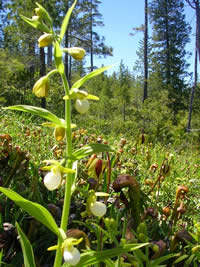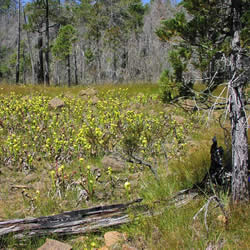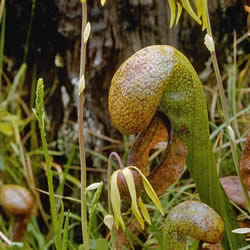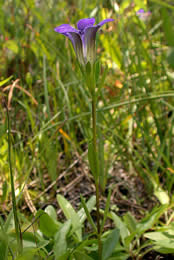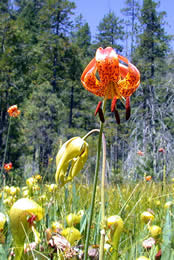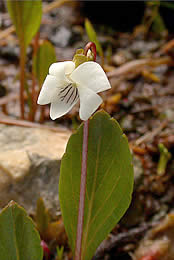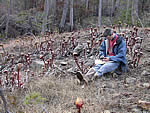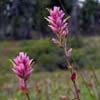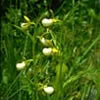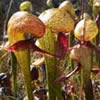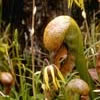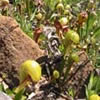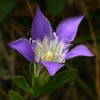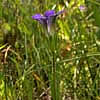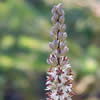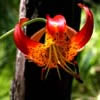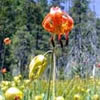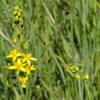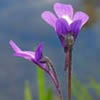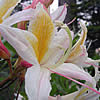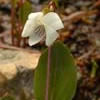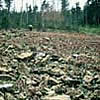USDA Forest Service Celebrating Wildflowers
|
|
|
Darlingtonia Wetlands, A Serpentine Classic
One and the SameDarlingtonia wetlands and wet meadows overlap like a Venn diagram, i.e. some Darlingtonia grows in wet meadows and some wet meadows have Darlingtonia. Neither is completely a subset of the other. Read more » Darlingtonia californica (California pitcher plant) occurs in localized seeps, streamsides, or across broad terraces from the Sierra Nevada Mountains of northern California to the Klamath-Siskiyou Mountains of southwest Oregon. Darlingtonia can grow on or off serpentine, but as member of a plant community. Darlingtonia wetlands reach their greatest extent on serpentine areas of the coastal Klamath-Siskiyou Mountains where wetland complexes, called terraces, can extend over 10 acres. In this geographic area, Darlingtonia wetlands occur at an average elevation of 1,815 feet and on flat to moderately steep slopes. Of these wetlands, most range in size from ½ to 1½ acres. Water pH averages eight, which is on the basic end of the pH scale. High pH serpentine seeps and springs are the focal sites for research of microbial life, here and on other planets. Hydrology is an important driver of these wetland communities. Variables related to geomorphic setting, water inflow and outflow, and water temperature provide for a diversity of plant communities. Hillslope springs, streamsides, and terraces are three broad categories of Darlingtonia plant communities. Where hillslope springs occur, groundwater finds its way to the surface through fracture serpentine rock at sites subject to slumping. Streamside wetlands develop on gravel bars along stream channels. Terrace wetlands occur as a complex of seeps that run together on broad, low gradient slopes of former stream benches. Species assemblages and community structure likewise vary across the Darlingtonia wetland types. Streamside wetlands maintain a rocky to gravely substrate with high shrub and tree cover whereas high organic matter and a high cover of herbs and sedges characterize those wetlands of low gradient water flow. Research NoteWhat do Darlingtonia wetlands and outer space have in common? A researcher from NASA is interested in finding out. Dr. Dawn Cardace is investigating the ancient subduction areas of the Klamath-Siskiyou Mountains, specifically their serpentine waters, for potential applications for life on other planets. Read more » Rare and endemic plant species array themselves across these broad community groups and are likewise correlated to variables related to hydrology, geomorphic gradient, and structure of vegetation. For example, the presence of Waldo gentian (Gentiana setigera) is correlated with high water flows, high grass/sedge cover, low shrub/tree cover, fine textured soils, and low to moderate slopes. Western bog violet (Viola primilifolia var. occidentalis) is associated with flowing water and high surface rock.
Research NoteFire is a primary disturbance agent of serpentine environments. What happens to Darlingtonia plant communities after fire? The focus of current research is to characterize recovery of these communities after fire. In one study, scientists assessed the effects of burning on Darlingtonia wetland vegetation and on a food source of Darlingtonia: ants. BookmarkspH - pH is the concentration of hydrogen ions in solution. The higher the hydrogen ion (H+) concentration, the lower the pH. The lower the concentration of hydrogen ions, the higher the concentration of hydroxide ions (OH-) which equates to higher pH values. pH measurements range from 0-14 with 7 being neutral. Measurements less than 7 are on the acidic end of the spectrum and those above 7 are basic or alkaline. Serpentine rocks, high in magnesium (Mg+), weather and release relatively high concentrations of Mg in the ground and surface water of serpentine areas. With the introduction of Mg+, the concentration of H+ is reduced, resulting in pH values above neutral. Photo Gallery
Our thanks to CalPhotos and its many contributors for many of the pictures in this photo gallery. Resources and References
|
|
| NOTE: PDF format links require the Adobe Acrobat Reader to view. | |
| top | Disclaimers | FOIA | Privacy Policy | Quality of Information | Photo Credits & Use |
Location: http://www.fs.fed.us/wildflowers/communities/serpentines/communities/darlingtonia.shtml
Last modified: Wednesday, 03-Dec-2008 13:54:21 EST
